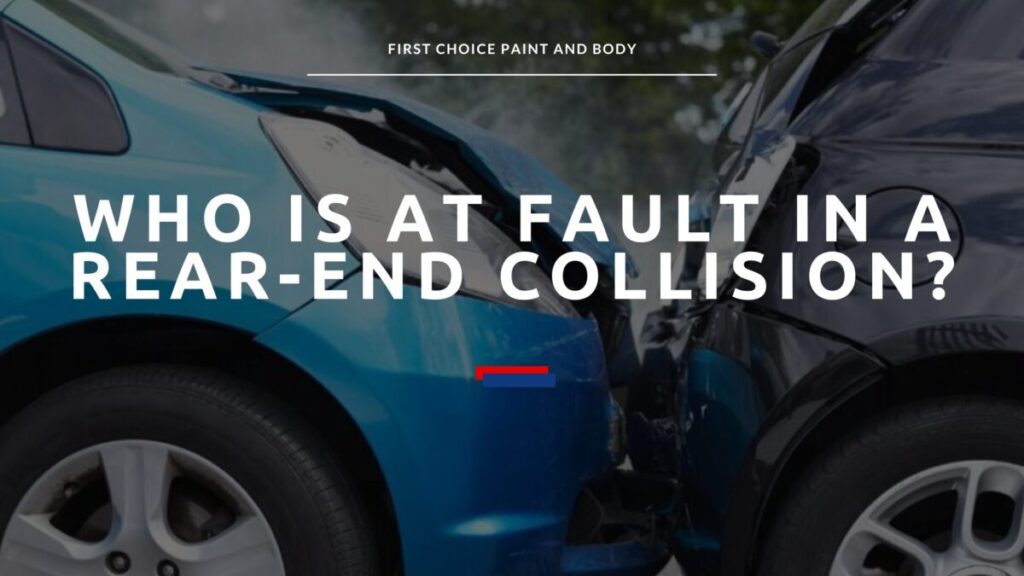Who is at Fault in a Rear-End Collision?

Rear-end collisions are among the most common types of car accidents, often leading to significant damage, injuries, and complicated legal and insurance issues. Understanding who is at fault in these incidents is crucial for drivers, accident victims, and legal professionals alike. This guide from collision repair experts will explore the common causes of rear-end collisions, how fault is determined, and the legal and insurance implications involved. Additionally, we will provide practical advice on what to do if you are involved in a rear-end collision.

Common Causes of Rear-End Collisions
Several factors can contribute to rear-end collisions, making them a frequent occurrence on roads. Here are some of the most common causes:
Distracted Driving
Distracted driving is one of the leading causes of rear-end collisions. When drivers take their eyes off the road, whether due to texting, adjusting the radio, or other distractions, they significantly increase the risk of not reacting in time to the vehicle in front of them.
Speeding
Driving at high speeds reduces the time a driver has to react to sudden stops or slow-moving traffic. Speeding can lead to a greater impact force during a collision, resulting in more severe damage and injuries.
Sudden Stops
Vehicles that make unexpected stops can catch the driver behind them off guard, leading to a rear-end collision. Sudden stops can occur due to various reasons, including traffic congestion, pedestrians, or obstacles on the road.
Weather Conditions
Adverse weather conditions such as rain, snow, or fog can reduce visibility and make roads slippery. Drivers may find it challenging to judge distances and stop in time, increasing the likelihood of a rear-end collision.
Tailgating
Following another vehicle too closely, or tailgating, reduces the reaction time available to avoid a collision. Maintaining a safe following distance is essential to prevent rear-end accidents.
Determining Fault
In most rear-end collisions, the driver of the vehicle that strikes another vehicle from behind is presumed to be at fault. This presumption is based on the idea that drivers should maintain a safe following distance and be prepared to stop if traffic conditions require it. However, there are exceptions and contributing factors that can influence fault determination.
General Presumption
The general presumption is that the rear driver is at fault because they failed to stop in time to avoid hitting the vehicle in front. This presumption aligns with traffic laws and the duty of care that drivers owe to others on the road.
Exceptions and Contributing Factors
While the rear driver is typically at fault, there are situations where the front driver may share or bear full responsibility for the collision. Some exceptions and contributing factors include:
- Sudden and Unpredictable Stops: If the front driver makes a sudden and unpredictable stop without reason, they may be partially at fault.
- Brake Lights Malfunction: If the front vehicle’s brake lights are not functioning properly, the rear driver may have a defense.
- Reversing Vehicle: If the front vehicle was reversing at the time of the collision, the fault may lie with the front driver.
Role of Traffic Laws and Regulations
Traffic laws and regulations play a crucial role in determining fault in rear-end collisions. For example, laws regarding safe following distances, speed limits, and driver conduct can all influence the outcome of a fault determination.
Legal and Insurance Implications
Understanding the legal and insurance implications of a rear-end collision is essential for navigating the aftermath of such an accident. Here are some key points to consider:
Impact on Insurance Claims and Premiums
Being found at fault in a rear-end collision can significantly impact your insurance claims and premiums. The at-fault driver’s insurance typically covers the damages to the other vehicle and any injuries sustained by the other driver. Additionally, the at-fault driver’s insurance premiums may increase due to the accident.
Comparative Negligence and Shared Fault Scenarios
In some cases, both drivers may share responsibility for the collision. Comparative negligence laws allow for the fault to be distributed between the parties based on the degree of negligence. For example, if the front driver made a sudden stop without reason, they may be found partially at fault, and the rear driver’s liability may be reduced accordingly.
Legal Steps to Take if Fault is Disputed
If the fault is disputed, it is essential to take certain legal steps to protect your rights. These steps include:
- Gathering Evidence: Collecting evidence such as photos, witness statements, and police reports can support your case.
- Consulting an Attorney: Seeking legal advice from an attorney experienced in car accident cases can help you navigate the legal complexities.
- Filing a Claim: Promptly filing a claim with your insurance company and providing all necessary documentation is crucial.
What to Do After a Rear-End Collision
If you are involved in a rear-end collision, taking the right steps can help ensure your safety and protect your interests. Here’s what you should do:
Ensure Safety
First and foremost, ensure your safety and the safety of others involved. If possible, move your vehicle to a safe location away from traffic. Turn on your hazard lights to alert other drivers.
Collect Evidence and Information
Gather as much information as possible at the scene of the accident. This includes:
- Photos: Take photos of the vehicles involved, the accident scene, and any visible damages or injuries.
- Witness Information: Collect contact information from any witnesses who can provide an account of the accident.
- Driver Information: Exchange contact and insurance information with the other driver(s) involved.
Report the Accident
Report the accident to the local authorities and your insurance company as soon as possible. Provide a detailed account of the incident and submit all collected evidence.
Conclusion
Determining fault in a rear-end collision can be straightforward, with the rear driver often presumed at fault. However, various factors can influence this determination, and understanding the legal and insurance implications is crucial. By following the recommended steps after a collision, you can ensure your safety and protect your rights. If you have questions or face disputes regarding fault, consulting with legal or insurance professionals is always a wise decision.
Back to top: Who is at Fault in a Rear-End Collision?
